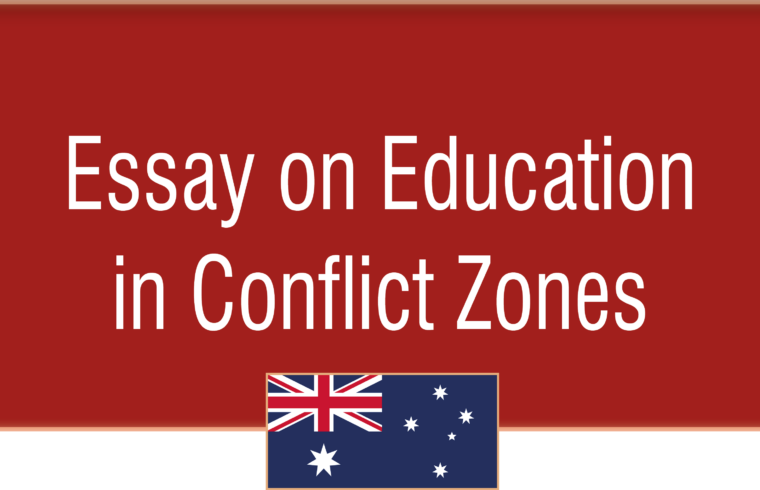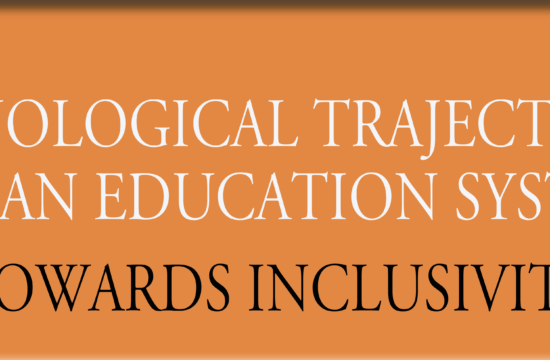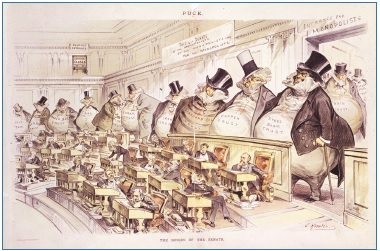Daniel Bruno Bonatti
Western Sydney University Student – AUSTRALIA
ABSTRACT
The Right to Education in Conflict Zones. Wars ignited by sectarianism and politics should not be barriers to education. These conflicts must not stop lifelong learning. Difficult answer to the question how to deal with this is action. Education in conflict zone is a priority. The how to do this is varied, through mentoring and teaching support, sent to conflict zones to replace civilian teachers. Mobilisation, pooled engagement, student, youth and adult outreach, STEM activities, home schooling or flown in and flown out (FIFO). These in combination give action which is yet to be realised. A call for more recognition for needs of education in conflict zones is required by United Nations, international charities, education professionals and worlds nations.
The United Nations Sustainable Development Goal 4 Quality Education stated, “Ensure inclusive and equitable quality education and promote lifelong learning opportunities for all” (UN-SDG 4, 2015) (WHO 2015). Sectarianism and Politics should not be barriers to Education. All people deserve the fundamental right to access Education. Moreover, in unfortunate situation of no education, around the world having become a conflict zone. Teaching facilities destroyed, with educators killed, and students kidnapped from classrooms (LeBlanc, J. and Odegard, S.,2023).
According to the United Nations (2023), suggested ethically people in conflict zones have access education. This right was declared by United Nations (2023) is termed the Safe Schools Declaration (2023). This allows any person in conflict zones the right to education. This Safe Schools Declaration (2023) bounds UN member states to continuance of education for teachers, schools, students, and universities during conflict and stop military use of such learning institutions.
Education in conflict zones barriers include poverty and hunger because of war. Sustainable Development Goal 1 No Poverty and 2. Zero Hunger are affected (UN SDG, 2015) (WHO 2015). These are knock on affect due to conflict. Destroying education structures and curriculum. According to UNICEF (2016) about fifty million children around the world were displaced due to poverty and twenty-eight million in conflict zones. Schools cannot function due to uncertainty and displacement of students, family, and community. This makes education a weapon of war, demonstrates the need for the United Nations, Safe Schools Declaration (2023) (Micallef, J., 2023).
Learning and teaching within conflict zones requires more recognition by United Nations, international charities, education professionals and worlds nations. The right to education in conflict zone must be a priority when this unfortunately happens. Fundamental is to keep children studying to avoid them going into forced labour or taken as recruits in the war. Education interventions can play a substantial allows for continued discussion, strengthening fragments of community, and ward off, future conflict.
The uncertainty of the conflict makes for lack of food, deepening poverty, and lack of education. This cycle must be stopped with introduction of reaching vulnerable. Therefore, a humanitarian approach with people at centre of the process be provided education when involved in conflict zone. Education in conflict zone is a priority. The how to do this is varied, through mentoring and teaching support, sent to conflict zones to replace civilian teachers. Mobilisation, pooled engagement, student, youth and adult outreach, STEM activities, home schooling or flown in and flown out (FIFO) (EWB 2023). Using locally sourced educational tools and materials being makeshift or flown in, are decisions needed immediately when conflict arises. Other possibilities are communication using internet though in conflict zones it is often first thing destroyed (Badrasawi, Ahmed, and Eid, 2018).
Methods employed to get children to school in conflict zones are varied not successful. Barriers to access education are a priority. The Convention of the Rights of the Child (CRC) (1989) established United Nations High Commissioner for Refugees UNHCR and NGOs to provide educational services to refugee children. Home schooling is an option. An example Gaza strip children cannot adapt to NGO School environment. Many people in conflict zones apply to United Nations High Commissioner for Refugees (UNHCR) in the hope of moving to a country where my children can obtain an education (Buitrago, A.O., 2011.). Children are compelled to community or sectarian schools, making a path to extreme ideologies. Most importantly quality standards are not upheld (Badrasawi, Ahmed, and Eid, 2018).
Unfortunate consequence of war is disablement of society this in turn have combatants prefer the education system collapse to create chaos (Micallef, J., 2023). The International community and United Nations are making every effort to make amends, on the ground with stakeholders of the conflict zone to assure the right of quality education once conflict ceases. Rebuilding educational system (Badrasawi, Ahmed, and Eid, 2018).
Conflict may mean teachers go to war. Volunteers need to take over. Many not paid, for interest of the children’s normality. Volunteering recognition is a priority in any conflict zone, and a conflict-sensitive approach is priority. Quality of education depends on sensitivity. This sensitivity must lessen conflicts trauma. Volunteer educators and existing educators need training due to conflict environment on sensitivities, including identification of educational needs and curricula which is conflict sensitive. International Organisations going to conflict zones must be education combat ready with procedures to cope in teaching. Teachers are central to the right of quality education not buildings. Otherwise, bias desensitise teaching just adds to war effort making bad ideology (EWB 2023).
Therefore, in doing so education is instrument reduce violence and conflict. Ignorant rhetoric leads to war. The learning of alternatives to conflict suggests promotes community consultation, collaboration, and cooperation to develop democratic principles, intern improving poverty, hunger, and education for economic good (LeBlanc, J. and Odegard, S., 2023).
Sectarianism and Politics should not be barriers to Education. All people deserve the fundamental right to access Education, even when in a conflict zone. Betterment of people’s lives depend on education and continuance during a conflict for all involved, irrespective of creed, race, religion, or political affiliation.
CONCLUSION
The focus of this paper is to make people aware of issues of education in conflict zones and barriers to implementation and access to education. Conflict zones circumstance makes education not possible and puts people in uncertainty and endangerment.
The paper makes recommendations on priorities for education in conflict zone and these are right to quality education, Education interventions the how, access through teaching, access of facilities, humanitarian approach with people at centre of the process be provided education Volunteering recognition is a priority in any conflict zone, and a conflict-sensitive approach is priority and Rebuilding education system when conflict ceases.
The removal of barriers to right of education in conflict zones means efforts by all stakeholder’s teachers, volunteers, students, children, adults, Local Community, United Nations the International communities, governments, international development partners, and international organizations. The efforts are to keep peace. Education stopping ignorant wars. Education promotes stability and social cohesion. Humanitarian intervention must include mitigation that education is priority as other humanitarian aid. Community transformation in peaceful society needs education. Education is the interconnection for tolerance, respect and understanding for communities. The result of quality education is betterment of life, sustainable practices, no more poverty and no more hunger and a prosperous economic future.
References
Badrasawi, K.J., Ahmed, I.O. and Eid, I.M., 2018.Exploring ways to provide education in conflict zones: Implementation and challenges. Intellectual Discourse, 26(2), pp.567-594.
Buitrago, A.O., 2011. Statelessness and human rights: the role of the United Nations High Commissioner for Refugees (UNHCR). Ejil-EAFIT Journal Of International Law, 2(2), pp.7- 23.
EWB 2023. Youth Outreach viewed 5/02/2024 < https://ewb.org.au/project/youth-outreach/>
LeBlanc, J. and Odegard, S., 2023. Leadership education as democracy‐in‐action: In pursuit of the United Nations Sustainable Development Goals. New Directions for Student Leadership, 2023(179), pp.97-110.
Micallef, J., 2023. Briefing of the United Nations Security Council Children and Armed Conflict: Prevention of Grave Violations. Sustainable Development Goal 1 No Poverty and 2. Zero Hunger are affected (UN SDG, 2015). The Convention of the Rights of the Child (CRC) (1989) established United Nations High Commissioner for Refugees UNHCR and NGOs to provide educational services to refugee children.
UNICEF. 2016, September 7). Nearly 50 million children “uprooted” worldwide. Retrieved August 25, 2017, from UNICEF: https://www.unicef.org/press-releases/ nearly-50-million-children-uprooted-worldwide.
United Nations, Safe Schools Declaration (2023).
United Nations Sustainable Development Goal 1 No Poverty, in all its forms anywhere.
United Nations Sustainable Development Goal 2 Zero Hunger A world with zero hunger can positively impact our economies, health, education, equality and social development.
United Nations Sustainable Development Goal 4 Quality Education, “Ensure inclusive and equitable quality education and promote lifelong learning opportunities for all” (UN-SDG 4, 2015).
United Nations High Commissioner for Refugees (UNHCR) 1950.
Universal Declaration of Human Rights, 1948
World Health Organization, 2015. Health in 2015: from MDGs, millennium development goals to SDGs, sustainable development goals.











